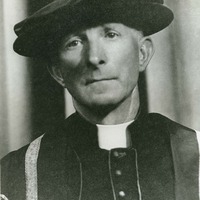 Monsignor John Hynes (Seán Ó hEidhin)
Monsignor John Hynes (Seán Ó hEidhin) This is a studio portrait of Monsigor John Hynes (Seán Ó hEidhin), at the time he was appointed as college president in 1934. He served until 1935. Affectionately known as 'Pa Hynes' to students, Monsigor Hynes was popular with students and staff and had already served in a number of capacities within the college. In 1911 he had been appointed dean of residences at UCG, before being appointed secretary in 1914 and registrar in 1916. In 1924 he became professor of archaeology, a position he retained when he assumed the role of president.
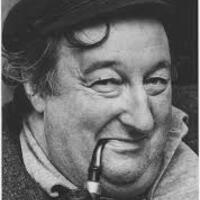 Prof. Pádraig Ó Céidigh
Prof. Pádraig Ó Céidigh Pádraig Ó Céidigh (1933-2008) was the first Professor of Zoology and head of department the University of Galway from 1962 until his retirement in 1999.
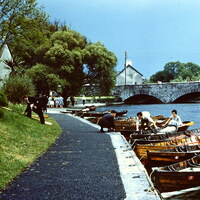 UCG Boat Club, 1959
UCG Boat Club, 1959 This photograph, taken in spring 1959, shows how the Boat Club was always a valued amenity just beside the main university buildings.
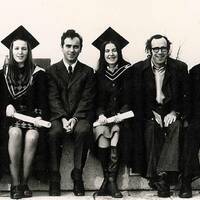 Physics graduates, 1976
Physics graduates, 1976 Among those pictured here are Tom O'Connor, Lecturer in Physics (1st on left) and Frank Imbusch, Professor of Physics (4th from left).
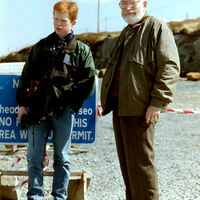 Breandán Ó Madagáin and his son on Aran, 1994
Breandán Ó Madagáin and his son on Aran, 1994 This photo of Breandán Ó Madagáin and his son was taken on the day of the launch of 'The Book of Aran'.
A noted Celticist and Irish scholar, Breandán Ó Madagáin (1932–9 January 2020) was originally from Limerick. He was a lecturer in Irish in UCG and then, from 1975 until his retirement in 1997, he was Professor and Chair of Irish there. His range of expertise covered folklore, sociolinguistics and Gaelic manuscript traditions.
His published work included several monographs: Teagasc ar an Sean-Tiomna (Teaching on the Old Testament), 1974; An Ghaeilge i Luimneach (The Irish Language in Limerick) 1974; Caointe and Seancheolta Eile/Keening and Other Old Musics, 2005. In 1978 he edited Gnéithe den Chaointeoireacht (Aspects of Keening). 'He was deeply interested in the connections between the traditional poetry of Gaelic society and its integral connection to song, writing several substantial articles on this topic ' (Ó Laoire, 2022).
In 1992 he was elected a member of the Royal Irish Academy, and from 1995-2005 he served as Chair of the Board of the Dublin Institute of Advanced Studies.
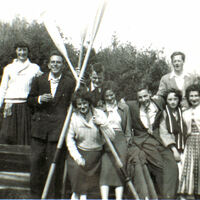 UCG students by the Corrib, 1955
UCG students by the Corrib, 1955 Taking a boat up the Corrib to relax has been one of the pleasures of student life over many decades.
The location of the University, with its main campus now stretching along the Corrib from Beggars Bridge to the playing fields near Menlo Castle has meant that the Boat Club has always been one of the most popular clubs in the University.
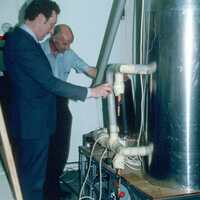 Inspecting Physics equipment, 1982
Inspecting Physics equipment, 1982 Tom O'Connor (left) and Frank Gaffney inspecting some equipment, most probably connected with Atmospheric Physics research.
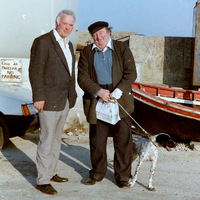 Pádraig Ó Céidigh at book launch on Aran, April 1994
Pádraig Ó Céidigh at book launch on Aran, April 1994 Pádraig Ó Céidigh was one of the many staff of NUI Galway who attended the launch of 'The Book of Aran' on a particularly fine day. He is holding a bag with the words 'Aran Heritage Centre' and has probably bought the book. He was a noted Marine zoologist and very much at home in this type of setting. He is accompanied y the inevitable dog.
Note the car parked in front of the no-parking sign.
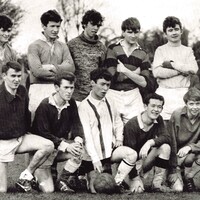 Comhairle Teachta na Mic Léinn (UCG Students Council) 1969
Comhairle Teachta na Mic Léinn (UCG Students Council) 1969 This is the 1969 CTM (Students Council) soccer team taking part in a Students Vs. Staff football match as part of the very first College Week in 1969. College Week replaced RAG Week, which the Bishop of Galway banned in the 1950s.
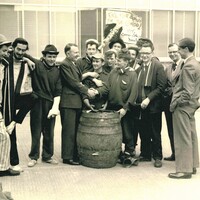 Students Barrel Roll from Galway to Dublin for charity.
Students Barrel Roll from Galway to Dublin for charity. In response to a famine in the Congo, in 1961 a group of UCG students decided to roll a Guinness barrel from Galway to Dublin for charity. The bands fell off the barrel by the time they got to St. Patrick's Church, so they borrowed a pram and continued on their journey to Ballinasaloe, pushing the barrel in the pram. By then the pram had 'given up the ghost' and a local auctioneer replaced it. Along the route they collected money and were provided with free hotel accommodation and meals. At Kinnegad a local blacksmith had to do emergency repairs to the pram, but the group eventually arrived at St. James' Gate in Dublin (where the photo was taken) and presented Major General J. Sweeney, general secretary of the Red Cross, with the proceeds of their charity walk, £135 - a considerable sum. Messrs. Guinness presented them with the barrel as a souvenir, and it was later displayed in a glass case at UCG.
Students (l-r) Ger Tuohy, Ray Walsh, Paddy Fox, Billy Walsh, Peter Flanagan, Paddy Walsh (half hidden), Manus McLafferty, Paddy Donoghue (wearing hat) Johnny Rooney and Kevin 'Doc' Doherty. Also in photo: Maj. General J. Sweeney, and three unidentified member of Guinness' staff.
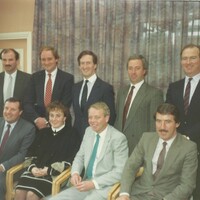 Galway-Derry-Boston Ventures
Galway-Derry-Boston Ventures This group from Galway participated with a group from Derry in a promotional visit to Boston in the mid-1980s, with a view to developing and promoting investment and economic development, tourism and other linkages. The initiative, with which John Hume was deeply involved from the outset, began with the Derry-Boston connection - which led to major economic developments in Derry - before becoming the Galway-Derry-Boston Ventures. The Galway group included representatives of the Chamber of Commerce, Údarás na Gaeltachta, the IDA and the University. On this occasion, the group joined up with the Derry delegation in Boston, whereas in 1990 (see RTÉ News report cited below) the special charter flight from Derry picked up the Galway group in Shannon.
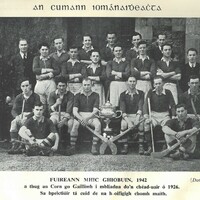 Fitzgibbon Hurling Team of 1942
Fitzgibbon Hurling Team of 1942 The picture shows eighteen men dressed in sports gear, with the front eight men holding hurling sticks or 'camáns'. Four of the men were Oifigí or Officers of the UCG Hurling Club, who were more formally dressed with ties. It was the occasion of the UCG Hurling Club winning the Fitzgibbon Cup (Wikipedia, Fitzgibbon, Apr. 2024) for the first time since 1926. The picture was taken by William Dowler, professional photographer, Presentation Road, Galway.
The picture appeared in Imleabhar (Volume) 3, Uimhir (Number) 1 of an Cumann Éigse is Seanchais's periodal FÍR, 1941-42.
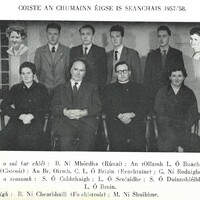 Coiste an Chumainn Éigse agus Seanchais 1957 – 58
Coiste an Chumainn Éigse agus Seanchais 1957 – 58 The picture is that of Coiste an Chumann Éigse is Seanchais 1957-58, with names given in the picture caption. It includes an tOllamh Liam Ó Buachalla, Lecturer in Economics, Commerce and Accountancy (1928-1952), Prof. of Economics, Commerce and Accountancy (1952-1969). Cumann Éigse is Seanchais produced the irisleabhar FÍR, whose holdings are in Archives & Special Collections of the University of Galway Library. It contains holdings from 1941, Imleabhar (Volume) III, Uimhir (Issue) I to 1958, Imleabhar IV, Uimhir 12 (Geraldine Curtin, 2024). Interestingly, the Eagarthóir (Editor) and Fo-Eagarthóir (Sub-Editor) of the 1941 – 42 Uimhir III, Irisleabhar FÍR was Seán Mac Réamoinn and Siobhán Nic Cionnaith.
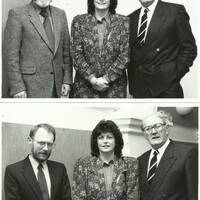 Léacht Bhord na Gaeilge, 1988 - Máire Geoghegan-Quinn
Léacht Bhord na Gaeilge, 1988 - Máire Geoghegan-Quinn Seo Máire Geoghegan-Quinn sa Choláiste le Léacht bhliantúil Bhord na Gaeilge a thabhairt i 1988. Ba Aire Stáit í i Roinn an Taoisigh ag an am. Léi sa ghrianghraf ar barr tá Uachtarán an Choláiste agus an tOllamh le Nua-Ghaeilge. Léi sa ghrianghraf ag bun tá Uachtarán an Choláiste agus an tOllamh le Geilleagar.
Máire Geoghegan-Quinn in the College to deliver the annual Bord na Gaeilge lecture in 1988. She was Minister of State in the Department of the Taoiseach at the time. With her in the upper photograph are the President of the College and the Professor of Modern Irish. With her in the lower photograph are the President of the College and the Professor of Economics.
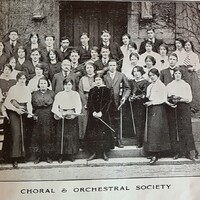 University Choral & Orchestral Society, 1915
University Choral & Orchestral Society, 1915 The first picture shows a combined group of orchestral people along with a choral group. The second picture shows the choral group on their own. Music notes describing some of their activities and renditions is given in an article ‘Music Notes’ (UCG Annal, 1915-16). Miss Fogarty was appointed Conductor of the University Choral & Orchestral Society in the first term of academic year 1915-16. The article described preparations for the upcoming Concert in the Town Hall. Rehearsals took place in the Greek Hall. A tour de force of the Choir was the Miserere scene from ‘Il Trovatore’. A minor hiccup occurred with the news that three or four prominent Society members were going to Cork to play in the Camogie Ashbourne Cup competition.
Carriages conveyed the artistes to the Town Hall on the night and ‘an excellent attendance was visible when the curtains rose’. Performances included a violincello solo of Mackenzie’s ‘Larghetto’ and ‘Allegretto’. A popular success of the evening was the rendering of ‘Teddy O’Neale’.
Dr. and Mrs Pye were thanked for their keen interest they took in the work of the Society – Professor Joseph Pye was then Registrar. Dr. Senier (Professor of Chemistry) and Prof. Rishworth (Professor of Civil Engineering) were also thanked in their respective capacities as President and Treasurer of the Society.
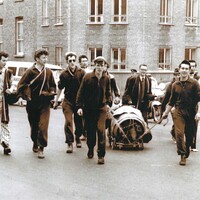 Student Barrel Roll for Charity
Student Barrel Roll for Charity In response to a famine in the Congo, in 1961 a group of UCG students decided to roll a Guinness barrel from Galway to Dublin for charity. The bands fell off the barrel by the time they got to St. Patrick's Church, so they borrowed a pram and continued on their journey to Ballinasaloe, pushing the barrel in the pram. By then the pram had 'given up the ghost' and a local auctioneer replaced it. Along the route they collected money and were provided with free hotel accommodation and meals. At Kinnegad a local blacksmith had to do emergency repairs to the pram, but the group eventually arrived at St. James' Gate in Dublin and presented Major General J. Sweeney, general secretary of the Red Cross, with the proceeds of their charity walk, £135 - a considerable sum. Messrs. Guinness presented them with the barrel as a souvenir, and it was later displayed in a glass case at UCG.
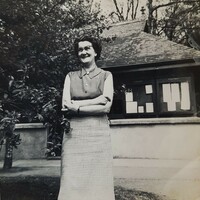 Mrs. Creaven 'Ma Creaven' and the college coffee shop
Mrs. Creaven 'Ma Creaven' and the college coffee shop Mrs. Anne Creaven, known to all as 'Ma Creaven', ran the college coffee shop from the early 1950s until her retirement in 1982. The coffee shop was the only place on campus where tea, coffee and food could be purchased, and it became the social hub of the college. The title 'Ma' was conferred on a few distinguished ladies in the college 'who had by their qualities of fairness, or learning, or strength of character or sheer personality, earned the respect of even the irreverent. One graduate described Mrs. Creaven as she 'stood at the cash register at the end of the counter, tweed suited in winter time, twinsetted by summer. She presided over her domain like a Sergeant Major over his barracks, and even the highest ranks acknowledged her dominion. Her eagle eye missed nothing, and her memory was elephantine.' Students were not permitted to linger too long in the coffee shop, and were encouraged by Mrs. Creaven to 'get up out of that and go to your lectures!' Nonetheless, her numerous acts of kindness to those in distress were fondly remembered by a great many students. Mrs. Creaven retired in October 1975. She died in June 1982.
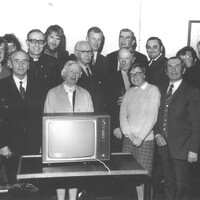 Fr Tom Kyne Retirement Presentation
Fr Tom Kyne Retirement Presentation This was a Retirement Presentation function for Fr Tom Kyne, (Catholic) Dean of Residence, in about 1974 in the Men's Club (as shown by the notice on the wall regarding the rules of Billiards).
He was presented with a television set at the function attended by a wide variety of his colleagues.
Fr Kyne's title was not 'Chaplain', but 'Dean of Residence', which was a statutory office from the outset as one of the 'Officers of Residence' (Statute I (1911), later retitled 'Deans of Residence'. Each religious denomination was entitled to nominate a clergyman for appointment as Dean of Residence in respect of students of that denomination. The Deans' duties involved supervision of the general conduct of students outside the precincts of the College, whereas the prime focus of the duties of the Lady Superintendent (also a statutory office) was the supervision of the conduct of women students within the precincts of the College. The establishment of 'Deans of Residences' from the early days of QCG (1857 onwards) in respect of each of the main religious denominations (although not taken up by the Catholic Hierarchy) was largely a means of enabling spiritual care for students of each denomination, linked to an inspection of the licensed boarding-houses where they stayed, all within the fraught environment of the establishment of the Queen's Colleges on a non-denominational basis.
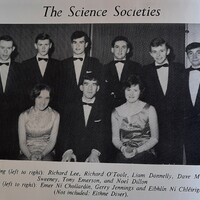 The Science Society
The Science Society The Scientific Society, later renamed the Science Society, was founded by Seán Óg (J.J.) McHenry, in 1928 (UCG College Annual, 1927-28). McHenry was appointed as Assistant Examiner in the Dept. of Experimental Physics & Mathematical Physics in 1922 (O’Connor, 1999) and became a Lecturer in 1929. He was awarded a D.Sc. degree in 1931. He went to University College Cork in 1933, becoming Prof. in Experimental Physics and later becoming President.
The Science Society later became known as ‘an Cumann Éargna Aicionta’. According to the UCG College Annual of 1957-58), ‘membership of the Science Society is confined to members of the Science Faculty proceeding to a purely scientific degree who pay one shilling subscription before the 1st of December’.
The ‘sister’ Cumann Ceimice na Gaillimhe was founded in 1949. The Cumann Ceimice was first to organise educational trips / tours abroad, with the first one taking place to Belgium in 1959. A tour to France in 1960 included members from the Science Society. The Science Society organised their first tour to the Continent (to Vienna) in 1965. This was followed by trips to Germany in 1966 and in 1968.
The inaugural Science Dress Dance took place in the Warwick Hotel in 1966. A picture of the Dress Dance Committee is shown with names given below the picture. The Science Dress Dance Committee in 1967 is also shown with names given below the picture.
Unfortunately, the Science Society became ‘extinct’ in the late 1980’s with the advent of new Societies which were more discipline oriented, such as the Physics Society formed in 1988.
 Cleaning the Clock Tower, mid 1970s to mid 1980s
Cleaning the Clock Tower, mid 1970s to mid 1980s This picture, taken from outside the Quadrangle, looking north-west, shows the iconic Clock Tower undergoing maintenance. Taken In the days before stringent health and safety rules were introduced, it shows the agility and bravery needed by Buildings & Grounds staff in order to keep the Virginia creeper from obscuring the College clock. The height of the Tower is 108 feet.
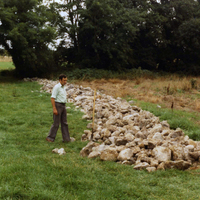 Bernard Finan checking materials for the playing fields, 1984-1986
Bernard Finan checking materials for the playing fields, 1984-1986 This photograph was taken, c. 1984-1986, during work on the foundations of playing-fields on the north campus, across from Menlo Castle .
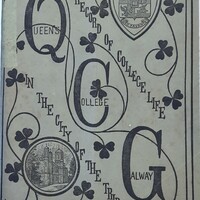 Earlier University Publications
Earlier University Publications The earliest known University magazine is that of Queens College Galway (Q.C.G.) publication that appeared in November 1902 entitled ‘A Record of College Life in the City of the Tribes’. The Vol. 1, No. 1 Editorial is shown here, as well as its front cover, which shows the University Arms and a picture of the University. It was published three times in the Collegiate year.
This was followed by the 'U.C.G. Annual' – the 1946 front cover is shown here. It later became known as the 'U. C. G. College Annual', as shown for the year 1957 – 58.
A magazine 'College Clarion' was produced in Dec. 1948, as shown by its front cover. It is not known if further issues were published.
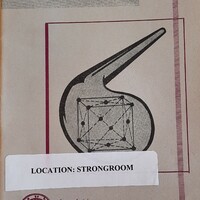 Science Magazines
Science Magazines Cumann Ceimice na Gaillimhe was founded in 1949 and was responsible for the publication ‘An Ailembic’ translated as ‘distillation’ which was first published in The Trinity Term of 1958. It ceased production in 1960. The Science Society produced ‘SPEICTREAM’ in 1966 and it continued for a few years. CRYSTAL was published by An Cumann Ceimice in 1968, which continued in production until 1981. Front covers of the three scientific magazines are shown.
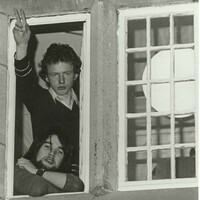 Student Occupation of President's Office, 1982
Student Occupation of President's Office, 1982 These are two of the students involved in an occupation of the President's Office on the second floor of the southwest corner of the Quadrangle, part of a group of 13 representing the Students’ Union . The occupation was initially meant to last 24 hours, but was extended from May 12 to May 21 in response to the actions of the college authorities in cutting off student phones, closing the Students' Union Bar, and attempting to cut off the nursery allowance. The occupation was in protest at the proposed increase in fees and cutbacks in essential Student Services. According to the Union's account, 1,000 students marched in support of the occupation on the eve of their examinations, but the increase in fees still went through.